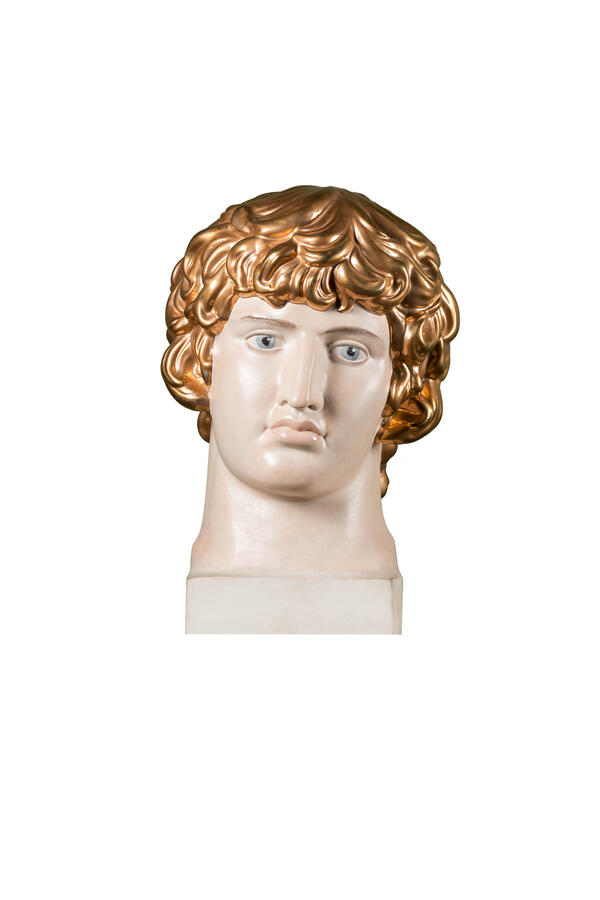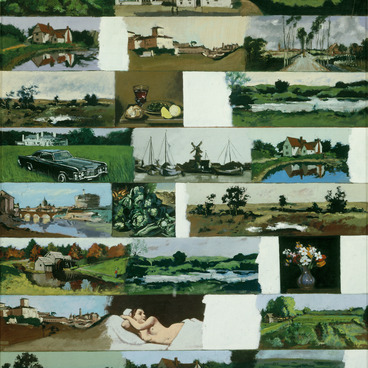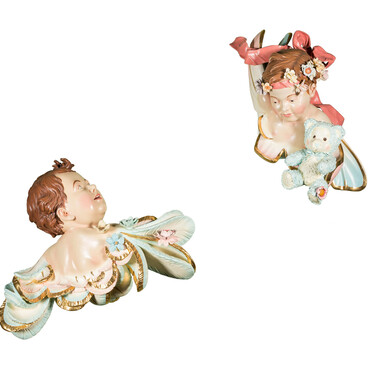Antinous was a Greek youth that lived in the early 2nd century. He was a beloved of the Roman emperor Hadrian. After his premature death, Antinous was deified in Ancient Rome: to commemorate him, a new city was founded, a constellation was named, and monuments were built.
The sculpture “Antinous’s Head” from the museum’s collection is a modern reinterpretation of the ancient story. It was created in the assisted readymade style by an artist from Saint Petersburg Olga Tobreluts in 2003. An “assisted readymade” is prefabricated objects or their components that the artist has modified or combined to create a new work of art. This method was also used by the famous artist Marcel Duchamp. In the early 20th century, Duchamp created a readymade called “L.H.O.O.Q.”, where he took a postcard reproduction of Leonardo da Vinci’s painting Mona Lisa and drew a mustache and beard in pencil onto it.
Olga Tobreluts used a typical plaster cast of Antinous’s head. She then covered the hair with gcold paint and painted the eyes blue, as well as colored the lips, highlighted the eyebrows, added a skin tone and color to his cheeks.
Olga Tobreluts was born in Leningrad in 1970. Her manner of painting was greatly influenced by her affiliation with the New Academy of Fine Arts founded by Timur Novikov in 1989. This community of young artists strove to preserve the traditions of academic art.
Tobreluts’s works often allude to classical images from the history of art and ancient culture and combine them with modern digital technologies. In 1993, the artist created her first series of computer collages “Imperial Reflections”, kept in the Russian Museum, which depict Tobreluts as an antique muse against the historical scenery in the background. These works bridge styles of several eras.
In 1995, Tobreluts participated in the exhibition “Passiones Luci”, which was organized by the New Academy of Fine Arts and featured works dedicated to a novel “The Golden Donkey” by Lucius Apuleius. The artist provided computer-made illustrations for the text and took on the role of the goddess Isis.
Nowadays, Olga Tobreluts lives and works in Saint Petersburg.
The sculpture “Antinous’s Head” from the museum’s collection is a modern reinterpretation of the ancient story. It was created in the assisted readymade style by an artist from Saint Petersburg Olga Tobreluts in 2003. An “assisted readymade” is prefabricated objects or their components that the artist has modified or combined to create a new work of art. This method was also used by the famous artist Marcel Duchamp. In the early 20th century, Duchamp created a readymade called “L.H.O.O.Q.”, where he took a postcard reproduction of Leonardo da Vinci’s painting Mona Lisa and drew a mustache and beard in pencil onto it.
Olga Tobreluts used a typical plaster cast of Antinous’s head. She then covered the hair with gcold paint and painted the eyes blue, as well as colored the lips, highlighted the eyebrows, added a skin tone and color to his cheeks.
Olga Tobreluts was born in Leningrad in 1970. Her manner of painting was greatly influenced by her affiliation with the New Academy of Fine Arts founded by Timur Novikov in 1989. This community of young artists strove to preserve the traditions of academic art.
Tobreluts’s works often allude to classical images from the history of art and ancient culture and combine them with modern digital technologies. In 1993, the artist created her first series of computer collages “Imperial Reflections”, kept in the Russian Museum, which depict Tobreluts as an antique muse against the historical scenery in the background. These works bridge styles of several eras.
In 1995, Tobreluts participated in the exhibition “Passiones Luci”, which was organized by the New Academy of Fine Arts and featured works dedicated to a novel “The Golden Donkey” by Lucius Apuleius. The artist provided computer-made illustrations for the text and took on the role of the goddess Isis.
Nowadays, Olga Tobreluts lives and works in Saint Petersburg.



